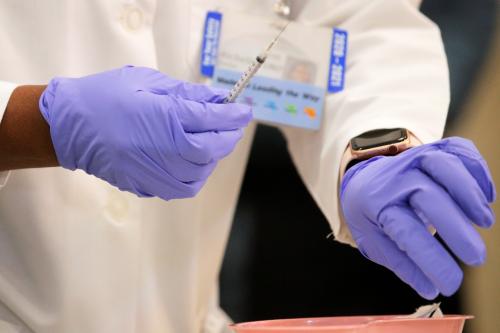We are living in a time of breathtaking advances in our understanding of how the human body works. We are learning what makes us function at the most fundamental level: that of genes and the proteins they produce. Automated analytical equipment—much of it based on the same powerful capabilities that have given us desktop supercomputers—now makes it possible for a research group to accomplish in a few weeks what would a few years ago have been unimaginably time-consuming.
Until recently, a veil of mystery obscured the myriad biochemical mechanisms that control the cells making up our bodies. Physicians and scientists fighting disease could observe only relatively superficial changes in response to their treatments. Today, however, we have the tools to tease out the fundamental mechanisms involved in disease and to put that knowledge to use. However uncomfortable it might make some people, human beings are in fact extremely complex machines that can be understood. The veil is starting to lift.
As we learn how our molecular components work, we are also learning how to manufacture and manipulate them. Clinical researchers are discovering how to use human molecules—genes, proteins, and antibodies-as drugs. Dozens of such drugs have already successfully run the gauntlet of clinical trials and been approved for use: clotting factors for hemophiliacs, Epogen for anemia, and Enbrel for rheumatoid arthritis, to name just three. These and other biopharmaceuticals have increased life span and quality of life for patients with diseases as diverse as cancer, multiple sclerosis, and diabetes.
Such natural human substances are destined to overtake the small-molecule drugs that dominated late 20th-century medicine, in terms both of therapeutic power and of market share. Indeed, as the traditional pharmaceutical industry faces a serious but little-recognized crisis of productivity, the science of genomics, a new discipline that has captured most human genes in a useful form, is entering its full flowering. While the rate of discovery of conventional drugs declines, genomics is identifying a rapidly increasing number of possible biopharmaceuticals.
Over the coming decade these two intersecting trends promise a sea change in the practice of medicine that portends proportionate change in the pharmaceutical industry. Drugs will become more effective, and some key players in the biotechnology sector will become industrial powerhouses. Medicines that cure disease and greatly reduce the cost of care, while providing many years of productive, active, healthy life will be developed, provided government policy, both in the United States and in other developed nations, supplies the necessary guarantees for protection of intellectual property and profit.
Regenerative Medicine and the Power of Biology
The reason biological molecules have such promise as medicine is that they can exert more subtle and proactive effects in the body than can conventional drugs. Whereas traditional drugs mostly work by inhibiting some cell constituent, a biological molecule can reprogram a cell, changing its activity and how it develops. By revealing the full range of natural biological molecules available for use as drugs, genomics has unlocked the potential tentatively demonstrated in the first phase of biotechnology more than a decade ago.
Last summer’s triumphant declaration of victory by the projects aiming to sequence the human genome has drawn much popular interest, even though the job is not yet truly finished. And even when it is, this scientific achievement will be largely a distraction as far as the business community is concerned. A large segment of the pharmaceutical industry has had almost all human genes to work with for about the past five years, through collaborations with my company and others that have made headway in identifying genes. We found them by means of a technique that isolates the active genes without requiring us to know the genome sequence.
Successful programs to develop drugs based on genes isolated this way are well in hand. Products are being tested in patients. Progress is encouraging, especially compared with the record of genome sequencing. Some 97 percent of the genome consists of “junk DNA” whose function, if any, is not apparent. What is more, genes exist in genomic sequence in a fragmented state that makes it impossible to recognize those not already identified by other means. We know this, because several potentially medically important human genes that reside in a part of the genome that has now been sequenced were completely missed by the sequencing team. They admitted they could not find novel genes in the genome sequence. Sequencing the genome has been likened to a biological moonshot. It may be a scientific tour de force, but the near-term practical benefits are few. Drugs derived from human genes isolated in their useful form, however, are like communications satellites: perhaps less eye-catching, but of greater long-term value.
Other headlines have made clear that virus-based gene therapy is proving harder to develop than some commentators had supposed. There have been well-publicized setbacks, such as the death of a young man in Philadelphia attributed directly to a gene therapy trial. But viruses are used in only one possible type of gene therapy, and many genomics-based drugs will not be gene therapies at all. Therapeutic proteins and antibodies may well dominate the sector. Progress in these areas is real and rapid, in part because proteins and antibodies raise fewer toxicological issues than small-molecule pharmaceuticals.
Genomics, then, has already proved itself to be an immensely productive source of candidate drugs. It allows scientists to approach the search for therapies in a systematic fashion. Today’s biotechnology products are only the first ripples of what will within a few years be a tidal wave of innovative, health-extending genomics products. Now that most human genes have been identified, the next task is to discover what they do. New methods have been developed to greatly simplify this task.
Companies such as mine are systematically screening isolated genes with properties likely to be useful in treating specific diseases. Drugs derived from these genes will become the basis of what I call “regenerative medicine,” a discipline that employs human substances to repair and restore damaged and worn-out tissues. Vaccines that fight and protect against cancer are another likely category of products, as scientists learn which genes misbehave in malignancy and devise strategies to counter them.
Genomics will also in time no doubt lead to the creation of much-improved small-molecule drugs, although these in general take longer to develop than biopharmaceuticals and are more susceptible to complications caused by drug interactions. For these reasons, it seems to me that biopharmaceuticals are where we will see the most remarkable medical progress over the next decade.
We hear a lot about how genetic research is likely to raise difficult societal issues, by providing disturbing predictions about who is likely to develop serious illness, for example. Such apprehensions are not groundless. We will indeed for some years to come be able to learn a lot about our genetic fate while having, in many cases, limited power to avert it. But this state of affairs stems from the aspect of genes that concerns why like begets like, from their role as determinants of inheritance. The future of medicine will, rather, emerge from genes considered as fundamental components of our anatomy that can control cells. Anatomic genomics holds the key to curing illness and repairing bodies.
The Next Waves
The reading public has in recent months been bombarded with dispatches not only about sequencing the genome and the travails of gene therapy, but also about experimental progress with stem cells. The practical implications of this progress do indeed seem to justify the attention being lavished on it, although many crucial questions are still being addressed. Researchers have isolated human stem cells that have a truly remarkable ability to transform into a wide variety of types. Moreover, cells with comparable flexibility may be obtainable from adult tissues. These discoveries will be synergistic with the use of human genes, proteins, and antibodies identified through anatomic genomics, and will constitute a second wave of regenerative medicine.
This second wave is already visible in outline. Physicians know now how to grow certain tissues for grafting, including skin, bladder, and cartilage, some of which are functioning in patients. Cultured cells have reportedly been used recently with some success in an experimental setting to treat stroke victims. It should be possible to use similar cells to treat a variety of disabling brain diseases.
Other types of cells have revealed newly promising potential for treating diabetes and liver failure. Genomics-derived drugs will vastly expand the range of treatments achievable with human cells, because they will provide the ability to control how cells specialize and grow. They are also likely to alleviate a key problem in using stem cells: growing enough to meet the clinical demand. Many human genes give rise to signaling molecules that, properly deployed, can stimulate cells to divide. Although many potentially useful stem cells cannot easily be grown now in large quantities, there is no reason to believe this limitation will be permanent. Human proteins identified through genomics will be essential for increasing the supply of therapeutic cells.
A third wave of regenerative medicine will arise when researchers are able to use the key insight from the experiment that produced Dolly, the cloned sheep-the insight that it is possible to reset the genetic clock inside a cell. The Dolly researchers reset that clock by implanting a cell nucleus in an egg cell, and the achievement has now been repeated many times in different species. I am confident that before long someone will discover how to bring about this change without the need for egg cells. This will lead to production of replacement tissues that are younger, in the important biological sense, than those of the patient being treated, although they will be genetically derived from the patient and so incapable of provoking immune rejection. It seems unarguable that this advance has the potential to extend productive human life greatly. By the time this technology is well developed, neuromechanical prostheses are likely to be in widespread use too. They will be the fourth wave of regenerative medicine.
The Role of Government Policy
Despite the current difficulties besetting the pharmaceutical industry, biopharmaceuticals offer a bright future for scientific medicine. But part of that bright future depends on sound government policy-specifically, policy regarding patent protection and pricing.
If biopharmaceuticals are to be a vibrant business sector-and a rich source of better medicines-continued strong patent protection is essential. Companies that spend hundreds of millions of dollars to develop a medicine need the assurance of a patent that the drug will not quickly be copied. Indeed, the feature of strong patentability further distinguishes human genes, proteins, and antibodies from small-molecule drugs, which are relatively easy to mimic in “me-too” versions different enough to avoid infringing a patent and thus able to steal market share, slashing returns on the original developer’s investment.
Continued investment in pharmaceutical development also depends on sound government policy. Only one medicine in three, historically, has earned its development costs, and although I expect genomics to improve that record, the need for large clinical trials ensures that drug development will always be expensive. If genomics companies are to continue finding investors willing to put funds into identifying and testing potent new gene-based pharmaceuticals, they must have confidence that the products of such expensive endeavors will not be subject to price controls. Controls on the prices of pharmaceuticals could be the surest way to undermine continued investment.
Price controls would assuredly limit the type and effectiveness of medicines available-without, in all likelihood, reducing the overall cost of illness. High-tech medicines, though expensive, can reduce total medical costs by cutting down on surgery and hospital and nursing home stays. They also improve people’s ability to work. One clot-busting drug for stroke, for example, saved an average of $4,400 per patient by reducing the need for rehabilitation and home care. A study by R.L. Legg in The Journal of Occupational and Environmental Medicine showed that employers saved $435 per employee per month with a new medicine for migraine that reduced absenteeism.
It should go without saying that science-based drugs have saved millions of lives and billions of dollars over recent decades. A recent study prepared for the Biotechnology Industry Organization by Parexel International Medical Marketing Services, Inc., shows that each of 57 biotechnology drugs reduces the total health care cost of treating diseases of the elderly. Yet these very real benefits tend to get lost in the clamor over drug prices associated with the high costs of prescription medication not now covered by most insurance plans, while the high likelihood of further radical improvements in medicines seems often to be overlooked. Politically expedient price control regimes have squeezed most of the life out of the nascent European and Japanese biopharmaceutical industries. What happened there could happen here if we let it.
Without question much needs to be done to improve access to pharmaceuticals, both domestically and internationally. In developed countries prescription drugs should be covered by insurance plans and by government-sponsored health programs, such as Medicare and Medicaid. Health benefits should be extended for everyone in the United States. We in the United States should work with international organizations to assure that all people, no matter where they may live, have access to basic, high-quality health care. A nation’s health care infrastructure, including access to effective medications, should assume a place of primary importance in developing countries, along with sound financial infrastructure and democratic institutions and physical infrastructure. The central challenge for health care policymakers is to broaden access without harming the biotechnology sector and so to bring the results of the genomics revolution to full fruition. It is within our grasp to turn the astounding technical progress of recent years into a medical legacy for the ages. Given the chance, the emerging breed of genomics-based biotechnology companies will do just that.



Commentary
Genomics
December 1, 2001